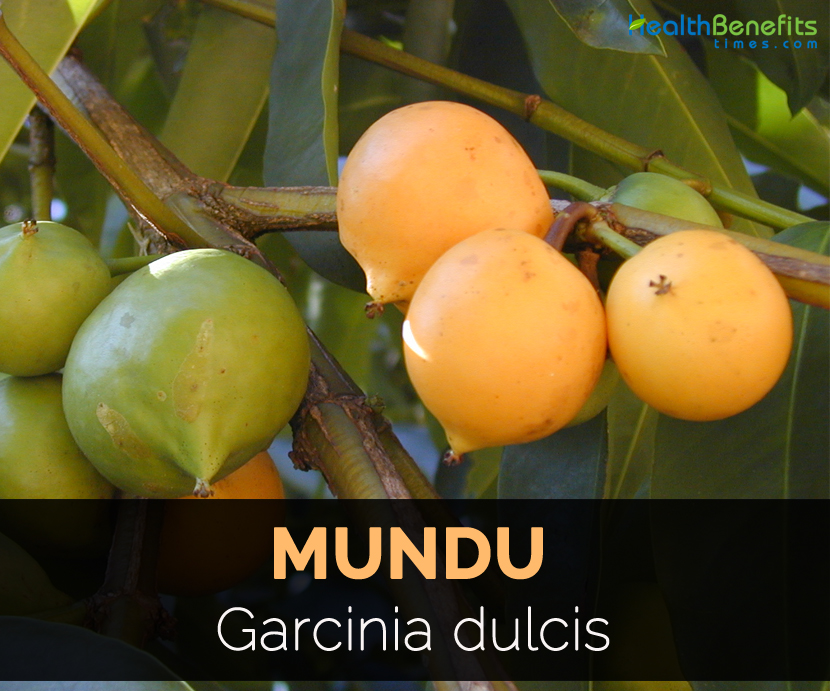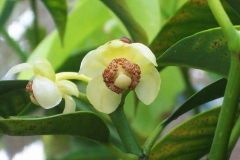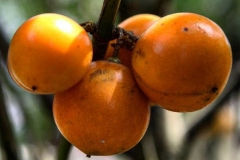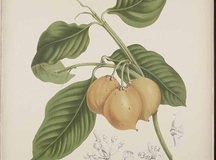| Mundu Quick Facts |
| Name: |
Mundu |
| Scientific Name: |
Garcinia dulcis |
| Origin |
Peninsular Malaysia, southern Thailand, Java, Borneo and the Philippines |
| Colors |
Yellow or deep yellow |
| Shapes |
Globose to oblate, 5–8 cm in diameter |
| Flesh colors |
Soft yellow |
| Taste |
Pleasant |
Also known as Baniti, Gourka, Egg Tree, Mundu and Rata Fruit, it is a sub-woody plant that belongs to Clusiaceae family well known as mangosteen and “the Queen of Fruits”. This species is found in humid and tropical forest in coastal areas and inland upto 500 meters altitude. It can also thrive in moist and shady environment. Mundu is an evergreen, medium sized and much branched perennial tree which measures 10-13 meters high with an upright growth habit. Bark is rough, dark brown and branches are green and sparsely hairy angled. Leaves are simple, opposite, large, ovate and oval to oblong about 10-30 cm long by 3-15 cm wide. Petioles are 1 to 2 cm long. Flowers are pentamerous having 5 sepals and 5 yellowish-green or yellowish-white petals. Male ones are smaller measuring 6 mm across with 5 adelphous stamens, yellow lobed central dis and a rudimentary pis-til. Fruits are globose to oblate measuring 5-8 cm in diameter and green when immature turning to yellow or deep yellow when ripe. Fruit has thin skin with yellow and fibrous pulp and 1-5 brown seeds each about 2.5 cm long.
Health Benefits of Mundu fruit
- Heal wounds
The fruit has an anti-inflammatory property which helps to heal wounds and pains. It is helpful to maintain skin health.
- Erase Pain
The injured or chafed skin will make pain which could be reduced by using Mundu fruit.
- Goiters
Besides injuries, it could be used to treat goiter. Sprinkle grounded goiter on affected part of goiter.
- Relieve abdominal pain
Mundu has saponin, flavonoids, toning and anti-inflammatory properties which is helpful to cure stomachache.
- Treat bile problems
Besides stomach health, the fruit is effective for treating bile problems. The mundu fruit helps the one to defecate.
- Treatment for Diarrhea
Diarrhea is caused due to lack of digestive section to solve or create dirt which is found on part of digestive tract treated with either making it difficult to pass.
- Treat enema
Enema is a disease which attacks bile. Mundu fruit is helpful in overcoming this problem.
- Helps bowel movement
People with too many bowel movements continuously find Mundu fruit to be helpful. Leaves are used to treat it.
- Treat Thrush
Mundu fruit has anti-inflammatory properties which help to eliminate thrush of mouth area.
- Helpful for bad breath
Bad breath is caused due to canker sores specified with deficiency of Vitamin C.
- Treat burns
Mundu fruit is used to treat burns.
Medicinal uses
- Crushed fruit extract is used to provide relief from scurvy in Thailand.
- Use the crushed bark extract to clean wounds.
- Apply the pounded leaves to cure swellings.
Culinary uses
- Consume it fresh or serve it in sherbets.
- Make the fruits into jam, fruit paste and butter.
- Fruits are cooked and candied.
References:
https://www.researchgate.net/publication/308476272_Garcinia_dulcis_Roxburgh_Kurz_Clusiaceae_a_new_distributional_record_for_Assam_India
https://www.itis.gov/servlet/SingleRpt/SingleRpt?search_topic=TSN&search_value=506128#null
https://en.wikipedia.org/wiki/Garcinia_dulcis
http://tropical.theferns.info/viewtropical.php?id=Garcinia+dulcis
https://www.rarepalmseeds.com/garcinia-dulcis
https://healthyperson45.blogspot.com/2019/06/top-11-for-health-benefits-of-fruit.html
Comments
comments





